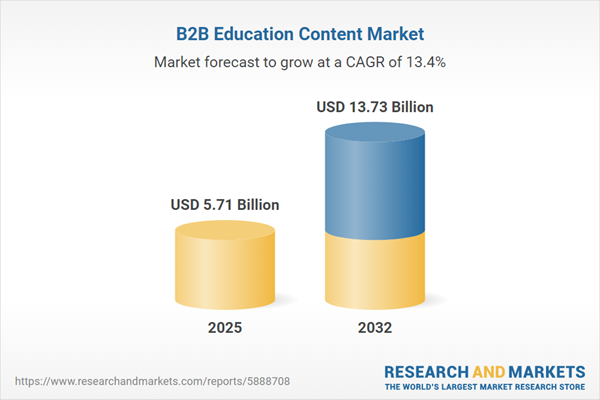Speak directly to the analyst to clarify any post sales queries you may have.
The B2B education content market continues to evolve rapidly as organizations seek smarter, adaptable solutions to develop workforce skills and address changing compliance obligations. Senior decision-makers increasingly rely on digital education strategies to ensure workforce readiness, future-proof talent, and maintain business agility.
B2B Education Content Market Snapshot
The global B2B education content market reached USD 5.02 billion in 2024 and is on track to achieve a 13.38% compound annual growth rate, with forecasts pointing toward USD 13.73 billion by 2032. This momentum is fueled by rising enterprise investment in cloud infrastructure and artificial intelligence, modernizing how organizations generate, deliver, and update learning experiences. Shifting workforce requirements and heightened compliance complexities are driving demand for customizable content and adaptive platforms. Companies are increasingly prioritizing collaboratives between industry leaders, regulatory agencies, and internal teams to develop learning programs tailored to specific roles and business goals.
B2B Education Content Market Scope & Segmentation
This report provides actionable segmentation and clarity for senior leaders managing procurement, strategic investment, or competitive positioning. It addresses the market’s core structure, drivers, and innovation opportunities through the following dimensions:
- Product Category: Assessment tools, authoring platforms, learning management systems, classroom management solutions, and student information systems each provide different benefits depending on the business’s training or compliance focus.
- Deployment Model: Organizations can select cloud-based, hybrid, or on-premise deployment modes according to needs around scalability, cost, and data security.
- Organization Size: Solutions scale to fit enterprises, mid-sized businesses, and small companies, supporting a range of complexity in training and compliance initiatives.
- End User Type: Corporate, public sector, universities, and K-12 entities require content that aligns with unique regulatory frameworks and engagement needs.
- Content Format: eLearning modules, interactive video, simulation-based learning, adaptive assessments, and downloadable resources cater to diverse learner preferences and measurement standards.
- Subject Area: Business, compliance, language training, soft skills, and STEM content provide organizations with comprehensive curriculum resources for workforce development.
- Technology Platform: Artificial intelligence, gamification, mobile and social tools, virtual reality, and analytics enhance engagement, deliver data-driven insights, and ensure reporting accuracy.
- Pricing Model: Procurement approaches include freemium, pay-per-use, subscription, and perpetual licenses, supporting flexible budgeting preferences.
- Implementation Services: Managed deployment, technical integration, and customized onboarding accelerate adoption and simplify change management.
- Support Services: Technical support, content management, and customer service optimize platform performance and help drive consistent adoption.
- Regional Coverage: The Americas, Europe, Middle East and Africa, and Asia-Pacific each present unique market drivers, regulations, and cultural nuances that influence adoption strategies and localization needs.
- Leading Companies: Market leaders include LinkedIn Corporation, Skillsoft Ltd., Coursera, Udemy, Pluralsight, Cornerstone OnDemand, SAP SE, Docebo, Learning Technologies Group, and GP Strategies Corporation.
B2B Education Content Market: Key Takeaways for Senior Stakeholders
- Hybrid and AI-enabled platforms offer essential flexibility, enabling organizations to align training with evolving workforce demands and compliance updates.
- Modular and microlearning content sustains continuous professional growth, encourages staff engagement, and ensures learning paths are relevant to specific job roles.
- Integration between learning systems streamlines compliance tracking for complex organizations, while maintaining accessibility for smaller organizations.
- Comprehensive service offerings that include content creation, technical integration, and ongoing support allow companies to minimize internal workload and improve implementation success.
- Localization strategies—incorporating local regulations and regional culture—promote higher engagement and support expansion into new territories.
- Long-term investment in advanced technologies, backed by robust support, better prepares the workforce for shifting business priorities and regulatory challenges.
Tariff Impact on Education Technology
Recent increases in U.S. tariffs impacting imported learning hardware have raised costs, steering many businesses toward domestic platforms and digital content subscriptions. This trend has intensified demand for adaptable, cloud-based education solutions that ease compliance with shifting trade conditions. Senior leaders can mitigate risk by selecting providers with reliable support systems and timely content updates, helping control costs and safeguard continuous learning delivery during periods of market uncertainty.
Methodology & Data Sources
Findings in this report are based on structured interviews with senior executives from the corporate, public sector, and academic environments. Data quality is ensured through industry benchmarking, regulatory landscape reviews, and insights from expert panels. This triangulated approach produces actionable recommendations tailored to market realities.
Why This Report Matters: B2B Education Content Market
- Empowers senior leaders to shape investment and procurement decisions with a clear understanding of workforce development and compliance needs.
- Delivers strategic segmentation and actionable analysis to inform scalable, regionally compliant talent development initiatives.
- Supports organizations in navigating digital transformation by providing insights for continual adaptation and business continuity in a changing landscape.
Conclusion
This report delivers focused guidance for optimizing B2B education content strategies, allowing decision-makers to build resilient teams and guide seamless transition through evolving technologies and regulations.
Additional Product Information:
- Purchase of this report includes 1 year online access with quarterly updates.
- This report can be updated on request. Please contact our Customer Experience team using the Ask a Question widget on our website.
Table of Contents
3. Executive Summary
4. Market Overview
7. Cumulative Impact of Artificial Intelligence 2025
Companies Mentioned
The companies profiled in this B2B Education Content market report include:- LinkedIn Corporation
- Skillsoft Ltd.
- Coursera, Inc.
- Udemy, Inc.
- Pluralsight, Inc.
- Cornerstone OnDemand, Inc.
- SAP SE
- Docebo Inc.
- Learning Technologies Group plc
- GP Strategies Corporation
Table Information
| Report Attribute | Details |
|---|---|
| No. of Pages | 198 |
| Published | October 2025 |
| Forecast Period | 2025 - 2032 |
| Estimated Market Value ( USD | $ 5.71 Billion |
| Forecasted Market Value ( USD | $ 13.73 Billion |
| Compound Annual Growth Rate | 13.3% |
| Regions Covered | Global |
| No. of Companies Mentioned | 11 |









